US-Iran tensions: Timeline of events leading to Soleimani killing
A look at the events leading to the US killing of Iran’s Qassem Soleimani and the escalation that followed.
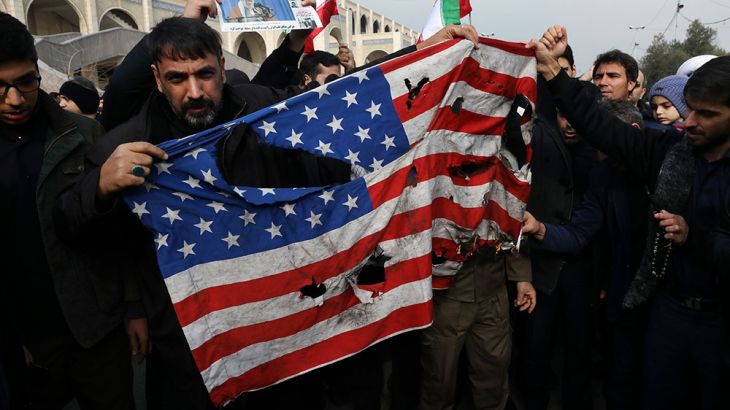
Tensions between the United States and Iran escalated dramatically last week after US President Donald Trump ordered the killing of top Iranian military commander Qassem Soleimani.
The attack at the Baghdad International Airport also killed Abu Mahdi al-Muhandis, the deputy commander of Iran-backed militias known as the Popular Mobilisation Forces (PMF).
Keep reading
list of 4 itemsExplosions kill dozens gathered for anniversary of Soleimani assassination
Iran blasts updates: Deadly explosions target Soleimani death anniversary
Deadly explosions in Iran during Soleimani anniversary procession
Iran’s Supreme Leader Ayatollah Ali Khamenei swiftly pledged to take “severe revenge” for Soleimani’s assassination.
Trump and US officials have defended the move, saying it was “self-defence”.
On Wednesday, Iran fired more than a dozen missiles at two Iraqi bases that house US forces. US and Iraqi officials said there were no casualties.
Here’s a look at the key events have led to the current situation:
2018
US withdraws from Iran nuclear deal
Trump made good on an election campaign promise, announcing on May 8 that the US was withdrawing from the Iran nuclear deal, formally known as the Joint Comprehensive Plan Of Action (JCPOA).
“I made clear that if the deal could not be fixed, the United States would no longer be a party to the agreement,” Trump said at the time. “The Iran deal is defective at its core.”
The JCPOA had tightly restricted Iran’s nuclear programme in return for ending sanctions that had severely damaged its economy.
In response, Iran called Trump’s decision “unacceptable” and said it would bypass Washington and negotiate with the deal’s other remaining signatories: France, Germany, the United Kingdom, Russia and China.
|
|
US sets outs tough demands
The US on May 21 demanded Iran make sweeping changes – from dropping its nuclear programme to pulling out of the Syrian war – or face severe economic sanctions.
The Trump administration’s 12 demands, which were outlined by US Secretary of State Mike Pompeo, were rejected by Tehran.
First round of sanctions
The US on August 7 reimposed the first round of sanctions on Iran, originally lifted as part of the nuclear deal.
They prohibited trade with a number of business sectors – from aviation and carpets to pistachios and gold.

Second round of sanctions
On November 5, the US announced a new round of sanctions, this time specifically targeting the key oil and banking sectors.
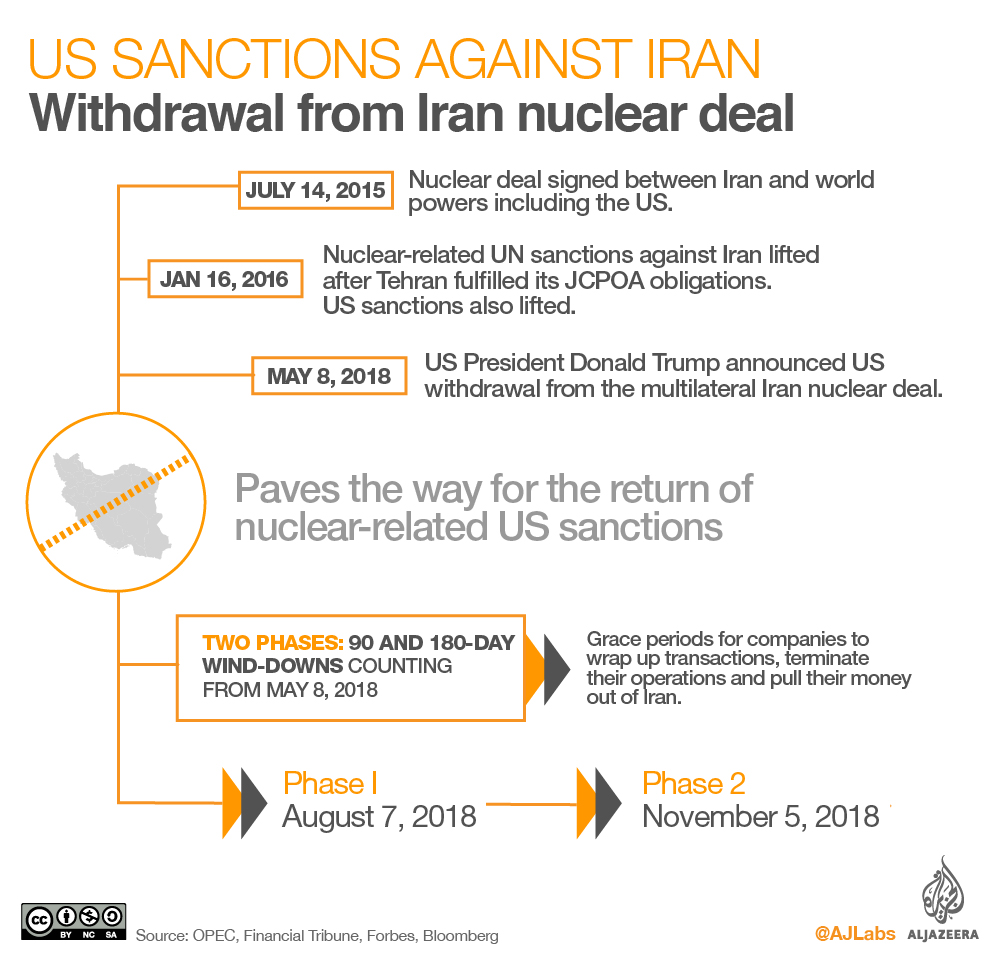
2019
‘Foreign terrorist organisation’
On April 8, Trump announced he was designating a powerful arm of the Iranian military, the elite Islamic Revolutionary Guard Corps (IRGC) as a foreign “terrorist” organisation.
It was the first time Washington formally labelled another country’s military a “terrorist group”.
The designation imposed wide-ranging economic and travel sanctions on the IRGC that went into effect on April 15.
Responding to the move, Iran immediately declared the US a “state sponsor of terrorism” and called Washington’s forces in the region “terrorist groups”.
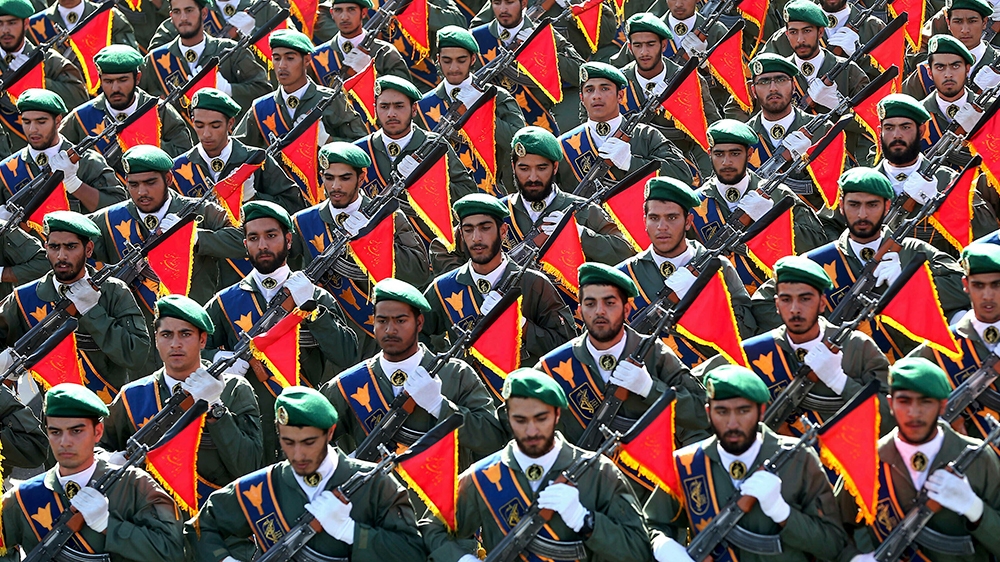
US sends aircraft carrier to the Middle East
On May 5, Trump’s then-National Security Adviser John Bolton announced the US was sending an aircraft carrier strike group and Air Force bombers to the Middle East “in response to a number of troubling and escalatory indications and warnings”.
“The United States is not seeking war with the Iranian regime, but we are fully prepared to respond to any attack, whether by proxy, the Islamic Revolutionary Guard Corps or regular Iranian forces,” Bolton said at the time.
More sanctions
On May 8, Iran said it was preparing to increase enriched uranium and heavy water production as part of its decision to stop certain commitments made under the nuclear deal.
A year after Washington withdrew from the deal and later reimposed sanctions on Tehran, Trump announced new measures against Iran’s steel and mining sectors.
Starting today, Iran does not keep its enriched uranium and produced heavy water limited. The EU/E3+2 will face Iran's further actions if they can not fulfill their obligations within the next 60 days and secure Iran's interests. Win-Win conditions will be accepted.
— Hassan Rouhani (@HassanRouhani) May 8, 2019
Tankers ‘subjected to sabotage operations’
On May 12, the United Arab Emirates said four commercial ships off the coast of Fujairah, one of the world’s largest bunkering hubs, “were subjected to sabotage operations”.
Officials identified the damaged ships as the Saudi oil tankers Al-Marzoqah and Amjad, the Norwegian tanker Andrea Victory, and a UAE bunkering barge, the A Michel.
Fujairah is the only Emirati terminal located on the Arabian Sea, bypassing the Strait of Hormuz through which most Gulf oil exports pass.
Iran, which has repeatedly threatened to close the Strait in case of a military confrontation with the US, called the incidents “alarming and regrettable”.
|
|
Houthis attack oil pipeline
Yemen’s Houthi rebels, who were locked in a long-running war with a Saudi-UAE-led military coalition, launched drone attacks on Saudi Arabia on May 14, striking a major oil pipeline and taking it out of service.
Two days later, Riyadh, a key US ally, blamed Iran for the attack.
The US and Saudi Arabia accused Iran of arming the Houthis, but Tehran denied the claim.
‘Never threaten the US’
On May 19, a rocket landed near the US embassy in Baghdad. No one was harmed.
It was not clear who is behind the attack, but Trump tweeted at the time: “If Iran wants to fight, that will be the official end of Iran. Never threaten the United States again!”
If Iran wants to fight, that will be the official end of Iran. Never threaten the United States again!
— Donald J. Trump (@realDonaldTrump) May 19, 2019
Iranian Foreign Minister Mohammed Javad Zarif responded by saying Trump had been “goaded” into “genocidal taunts”.
Goaded by #B_Team, @realdonaldTrump hopes to achieve what Alexander, Genghis & other aggressors failed to do. Iranians have stood tall for millennia while aggressors all gone. #EconomicTerrorism & genocidal taunts won't "end Iran". #NeverThreatenAnIranian. Try respect—it works!
— Javad Zarif (@JZarif) May 20, 2019
After meeting Japanese Prime Minister Shinzo Abe, who offered to broker dialogue between Washington and Tehran, Trump said on May 27 the US was “not looking for regime change” in Iran.
|
|
Shinzo Abe in Tehran
On June 12, Abe arrived in Tehran in a bid to mediate between the US and Iran.
A day later, he met Iran’s Supreme Leader Ayatollah Ali Khamenei who told him: “I don’t consider Trump as a person worthy of exchanging messages with. I have no response for him and will not answer him.”
|
|
New shipping incident
On June 13, with Abe still in Iran, a Japanese tanker and a Norwegian one came under “attack” in the Gulf of Oman, according to the Norwegian maritime authority and the Japanese shipowner.
The US Fifth Fleet said it received two separate distress calls from the tankers in a “reported attack”.
Iran spoke initially of “accidents” and said it rescued 44 crew members. Zarif called tanker “attacks” during Abe’s visit “suspicious”.
More US troops in the region
On June 17, the Pentagon authorised the deployment of 1,000 additional troops to the Middle East.
On the same date, Iran said it was 10 days away from surpassing the limits set by the nuclear deal on its stockpile of low-enriched uranium.
Iran said it could reverse the move if the deal’s European signatories step in and make an effort to circumvent US sanctions.
US drone is shot down
On June 20, Iranian forces shot down a US military drone.
Both countries confirmed the incident but offer diverging accounts about the location of the aircraft.
The US said it was flying above international waters, while Iran said the drone was flying in Iranian airspace.
|
|
Trump says he has called off an attack
On June 21, Trump said he called off a military strike on Iran the night before, which was intended as retaliation against Tehran for the downing of the unmanned US drone.
Trump said he did so 10 minutes before the planned attack because of potential casualties, saying it was “not proportionate to shooting down an unmanned drone”.
Trump said a US strike could have killed 150 people, and signalled he was open to talks with Tehran.
….proportionate to shooting down an unmanned drone. I am in no hurry, our Military is rebuilt, new, and ready to go, by far the best in the world. Sanctions are biting & more added last night. Iran can NEVER have Nuclear Weapons, not against the USA, and not against the WORLD!
— Donald J. Trump (@realDonaldTrump) June 21, 2019
Iran to ‘confront and threat’
On June 22, Iran said it was ready to respond firmly to any US threat against it.
“We will not allow any violation against Iran’s borders. Iran will firmly confront any aggression or threat by America,” said Abbas Mousavi, foreign ministry spokesman.
On the same day, Iran ordered the execution of a “defence ministry contractor” convicted of spying for the US Central Intelligence Agency, while the US vowed to impose fresh sanctions, adding that military action was still “on the table”.
New US sanctions
On June 25, Trump signed an order targeting Khamenei, Iran’s supreme leader, and associates with additional financial sanctions
“Sanctions imposed through the executive order … will deny the supreme leader and the supreme leader’s office, and those closely affiliated with him and the office, access to key financial resources and support,” the US president said.
Responding to the announcement, Zarif, the Iranian foreign minister, tweeted that hawkish politicians close to Trump were thirsty for war rather than diplomacy.
.@realDonaldTrump is 100% right that the US military has no business in the Persian Gulf. Removal of its forces is fully in line with interests of US and the world. But it's now clear that the #B_Team is not concerned with US interests—they despise diplomacy, and thirst for war.
— Javad Zarif (@JZarif) June 24, 2019
Rouhani dismissed the sanctions as “outrageous and idiotic”, adding that Tehran’s “strategic patience” should not be mistaken for fear.
US deploys F-22 stealth fighters
On June 29, the US Air Forces Central Command said in a statement that F-22 Raptor stealth fighters were being deployed in the region “to defend American forces and interests”.
Tehran exceeds uranium limit
On July 1, Iran exceeded the limit on the amount of enriched uranium in its stockpile set out in the nuclear deal.
The United Nations’s atomic watchdog confirmed that its inspectors had verified the 300kg cap had been breached.
Zarif said the accumulation of more enriched uranium than permitted under the deal was not a violation of the pact.
Tanker carrying Iranian oil stopped
On July 4, British Royal Marines, police and customs agents in Gibraltar seized a supertanker accused of carrying Iranian crude oil to Syria in breach of European Union sanctions.
The Grace 1 vessel was boarded on Thursday when it slowed down in a designated area used by shipping agencies to ferry goods to ships in the UK territory along Spain’s southern coast.
Iran passes new nuclear deal limit
On July 8, Iran passed the uranium enrichment cap set in the nuclear deal, the second time in a week that it made good on a promise to reduce compliance with the accord.
|
|
Captain of Iranian vessel arrested
On July 12, police in Gilbratar arrested the captain and chief officer of an Iranian tanker that was seized by British forces the previous week.
Iran seizes British oil tanker
On July 19, the IRGC said its forces seized a British oil tanker in the Strait of Hormuz.
The Stena Impero tanker “was confiscated by the Revolutionary Guards at the request of Hormozgan Ports and Maritime Organisation when passing through the Strait of Hormuz, for failing to respect international maritime rules”, the force said in its official website at the time.
IRGC releases a video of the moment that their forces seized #British #tanker #StenaImpero in #StraitOfHormuz. #Iran #IRGC #UnitedKingdom pic.twitter.com/29Q11mgzFP
— Press TV (@PressTV) July 20, 2019
British navy to escort all UK vessels in Strait of Hormuz
On July 25, the UK announced the country’s warships would escort all British-flagged vessels through the Strait of Hormuz, a change in policy that took place amid rising tensions in the Gulf.
HMS Montrose, a British frigate, was tasked to sail alongside the ships for protection.
“Freedom of navigation is crucial for the global trading system and world economy, and we will do all we can to defend it,” a UK government spokesperson said.
US sanctions Zarif
On August 1, the US imposed sanctions on Zarif for acting on behalf of Khamenei.
“Javad Zarif implements the reckless agenda of Iran’s Supreme Leader, and is the regime’s primary spokesperson around the world,” Treasury Secretary Steven Mnuchin said in a statement at the time.
Zarif brushed off the move on Twitter, saying it indicates Washington saw him as a “threat”.
“It has no effect on me or my family, as I have no property or interest outside of Iran,” he said.
The US' reason for designating me is that I am Iran's "primary spokesperson around the world"
Is the truth really that painful?
It has no effect on me or my family, as I have no property or interests outside of Iran.
Thank you for considering me such a huge threat to your agenda.— Javad Zarif (@JZarif) July 31, 2019
Seized Iranian tanker free to sail
On August 15, Gibraltar’s Supreme Court ruled that the Grace 1 was free to sail, just hours after the US made a last-minute attempt to keep the vessel under detention.
|
|
Iran unveils new missile defence system
On August 23, Rouhani inducted a locally built air-defence system into the country’s missile defence network at an unveiling ceremony in Tehran.
Iran began production after the purchase of Russia’s S-300 system was suspended in 2010 due to international sanctions that have barred it from importing many weapons.
Speaking at the ceremony, Rouhani said the mobile surface-to-air system was “better than S-300 and close to [more advanced] S-400”.
|
|
Zarif meets Macron
On August 26, Iran‘s top diplomat held talks with France‘s President Emmanuel Macron at the sidelines of a G7 summit following a surprise invite to the gathering in Biarritz.
“Iran’s active diplomacy in pursuit of constructive engagement continues,” Zarif said. “Road ahead is difficult. But worth trying.”
On the same day, Iran said it sold 2.1m barrels of crude oil on board the tanker that was seized in Gibraltar the previous month, adding that the vessel’s new owner will decide on its next destination.
Iran further exceeds nuclear-deal limits
On August 30, the UN said Iran was still exceeding limitations set by its nuclear deal with world powers, increasing its stock of enriched uranium and refining it to a greater purity than allowed in the agreement.
The quarterly report from the UN’s International Atomic Energy Agency confirmed Iran was progressively backing out of the pact in retaliation for the US’s withdrawal from the accord and the subsequent renewal of sanctions that had hit Iranian oil sales.
Sanctions on Iran’s space agencies
On September 3, the US imposed sanctions on Iran‘s civilian space agency and two research organisations, saying they were being used to advance Tehran’s ballistic missile programme.
The measures imposed by the US Department of the Treasury targeted the Iran Space Agency, Iran Space Research Center and the Astronautics Research Institute.
“The United States will not allow Iran to use its space launch program as cover to advance its ballistic missile programs,” said US Secretary of State Pompeo.
US intensifies pressure
On September 4, the US turned up the economic pressure on Iran, blacklisting an oil shipping network that Washington alleges is directed by the IRGC.
The US Treasury accused the blacklisted group of firms, ships and individuals of breaching sanctions by supplying Syria with oil worth hundreds of millions of dollars.
The Trump administration, meanwhile, said it would not accommodate a proposal by France to throw a financial lifeline to Tehran.
US offers money to captain of Iranian tanker
The US offered several million dollars to the Indian captain of an Iranian oil tanker suspected of heading to Syria, the State Department confirms.
The Financial Times reported on September 5 that Brian Hook, the State Department point man on Iran, had sent emails to captain Akhilesh Kumar in which he offered “good news” of millions in US cash for the captain to live comfortably if he steered the Adrian Darya 1, formerly known as Grace 1, to a country where it could be seized.
Iran activates advanced centrifuges
On September 7, Iran started injecting gas into advanced centrifuges to increase its stockpile of enriched uranium and warned that time was running out for the nuclear deal’s other signatories to save the landmark pact.
Spokesman Behrouz Kamalvandi said Iran’s Atomic Energy Organisation started up advanced centrifuges at the enrichment facility in Natanz, the third step by Tehran in scaling back its commitments under the crumbling pact following Washington’s withdrawal.
Bolton fired ‘over Iran’
Trump on September 10 announced via Twitter that he had fired Bolton, his national security adviser, saying he had “strongly disagreed” with many of his hawkish positions.
Bolton’s sacking was reportedly linked to a fundamental disagreement over the possible easing of US sanctions on Iran.
Taking aim at Bolton, Iran said the US should distance itself from “warmongers”.
Iran rejects accusation over Aramco attack
On September 14, Yemen’s Houthi rebels claimed responsibility for drone attacks on two major Saudi Aramco oil facilities: Abqaiq – the world’s largest oil processing plant – and the Khurais oilfield, in eastern Saudi Arabia. The pre-dawn strikes knocked out more than half of crude output from the world’s top exporter.
Pompeo swiftly blamed Iran, saying it “has now launched an unprecedented attack on the world’s energy supply”.
“There is no evidence the attacks came from Yemen,” Pompeo said on Twitter, referring to the Houthis’s claim of responsibility. He does not provide any evidence to support his claim.
Iran dismissed the “meaningless” US allegations, saying they were meant to justify actions against the country.
Trump lashes out at Iran at UNGA
Addressing the UN General Assembly in New York, Trump on September 24 lashed out at Iran and called on countries around the world to tighten the economic noose around it.
“One of the greatest security threats facing peace-loving nations today is the repressive regime in Iran,” he said.
“The regime’s record of death and destruction is well known to us all. Not only is Iran the world’s number one state sponsor of terrorism, but Iran’s leaders are fuelling the tragic wars in both Syria and Yemen, and at the same time the regime is squandering the nation’s wealth and future in a fanatical quest for nuclear weapons.”
US sanctions on Khamenei’s inner circle
The US on November 4 imposed new sanctions on the inner circle of Supreme Leader Ayatollah Ali Khamenei, including one of his sons.
The US Treasury said that the nine people sanctioned included Khamenei’s chief of staff, the head of the judiciary and senior military figures. It said it also blacklisted Iran‘s Armed Forces General Staff.
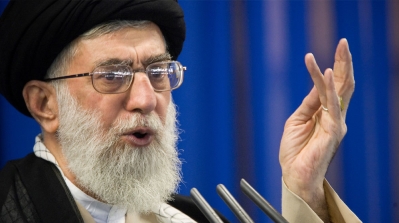
Iran’s foreign ministry spokesman Abbas Mousavi described the sanctions “a sign of the desperation and inability of this regime in benefiting from a diplomatic and logical approach” to important international issues, according to the official IRNA news agency.
Iran begins fuelling centrifuges
Iran on November 6, began the process of injecting uranium gas into centrifuges at the underground Fordow facility.
Behrouz Kamalvandi, spokesperson for the Atomic Energy Organisation of Iran, told state television that the agency has delivered 2,000kg (4,400 pounds) of uranium or UF6 to the Fordow plant, under the supervision of UN inspectors.
Operation to protect Gulf waters
A US-led naval coalition officially launched operations in Bahrain on November 7 to protect shipping in the troubled waters of the Gulf, following a string of attacks that Washington and its allies blamed on Iran.
Iran, which denied any responsibility for the mystery attacks, put forward its own proposals for boosting Gulf security that pointedly excluded outside powers.
‘Nuclear breakout’
US Secretary of State Mike Pompeo accused Iran on November 7 of preparing “a rapid nuclear breakout”.
Iran’s plans to increase its nuclear activity at Fordow raise concerns that Iran is positioning itself for a rapid nuclear breakout. It is now time for all nations to reject its nuclear extortion and increase pressure.
— Secretary Pompeo (@SecPompeo) November 7, 2019
Iran downs ‘foreign’ drone
Iran’s state news agency IRNA says air defence forces shot down an “unknown” drone on November 8.
The United States Central Command released a statement later that Friday saying that the downed drone was not one of theirs, and that all military drones were accounted for.
Alleged reports of a U.S. drone being shot down are incorrect. If a UAS had gone down in the CENTCOM AOR it was not a #DoD asset. All U.S. equipment has been accounted for.
— U.S. Central Command (@CENTCOM) November 8, 2019
“Alleged reports of a US drone being shot down are incorrect. If a UAS had gone down in the CENTCOM AOR it was not a DoD asset,” US Central Command said in a post on Twitter.
Unrest erupts
Unrest in Iran erupted on November 15 after the government abruptly raised fuel prices by as much as 300 percent.
The unrest spread to more than 100 Iranian cities and towns and turned political as young and working-class protesters demanded that religious leaders step down.
The death toll of the unrest varied. The opposition said at least 631 people were killed, while Amnesty International put the figure at more than 300. Both numbers were dismissed by Iranian authorities.
US sanctions on Iran’s information minister
The US on November 22 imposed sanctions on Iran’s communications minister Mohammad Javad Azari-Jahromi for his role in “widespread censorship”.
“Iran’s leaders know that a free and open internet exposes their illegitimacy, so they seek to censor internet access to quell anti-regime protests,” US Treasury Secretary Steven Mnuchin said in a statement.

“We are sanctioning Iran’s Minister of Information and Communications Technology for restricting internet access, including to popular messaging applications that help tens of millions of Iranians stay connected to each other and the outside world,” he added.
Iran guard chief
Addressing thousands of demonstrators in the capital, General Hossein Salami on November 25 accused the US, the United Kingdom, Iraq and Saudi Arabia of stoking unrest in the country.
“We have shown restraint … we have shown patience towards the hostile moves of America, the Zionist regime [Israel] and Saudi Arabia against the Islamic Republic of Iran … but we will destroy them if they cross our red lines,” he said.
Eight with ‘links to CIA’ arrested
The official news agency IRNA reported on November 27 that Iranian security agents arrested at least eight people linked to the CIA during deadly unrest over petrol price increases.
“These elements had received CIA-funded training in various countries under the cover of becoming citizen-journalists,” IRNA quoted the intelligence ministry as saying. “Six were arrested while attending the riots and carrying out [CIA] orders and two while trying to … send information abroad.”
Pentagon denies considering more troops
The Pentagon on December 4 denied a report that the US was weighing sending up to 14,000 more troops to the Middle East to confront a perceived threat from Iran.
The Wall Street Journal had earlier reported that the possible deployment would include “dozens” more ships and double the number of troops added to the US forces in the region.
Warship seized
A US Navy warship seized advanced missile parts on December 4 believed to be linked to Iran from a boat it had stopped in the Arabian Sea.
In a statement, the Pentagon said a US warship found “advanced missile components” on a stateless vessel and an initial investigation indicated the parts were of Iranian origin.
Prisoner swap
In a rare act of cooperation, Iran and the US on December 7 exchanged prisoners.
Xiyue Wang, a Chinese-born US citizen held in Iran since 2016, was exchanged for Massoud Soleimani, an Iranian scientist detained in the US.
The swap was facilitated by the Swiss government.

‘Budget of resistance’
On December 8, Iran’s President Hassan Rouhani announced a $39bn “budget of resistance” to counter US sanctions.
Rouhani said the aim was to reduce “hardships” to help Iran’s people overcome economic difficulties.
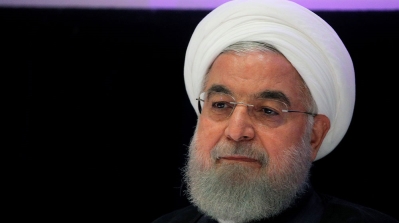
“Contrary to what the Americans thought, that with the pressure of sanctions our country’s economy would encounter problems, thank God we have chosen the correct path … and we are moving forward,” he said.
The budget included a 15 percent wage increase for public-sector employees.
Sanctions on Iran’s biggest airline
On December 11, the US Treasury imposed new sanctions on Iran’s biggest airline and its shipping industry, accusing them of transporting lethal aid to Yemen.
US Secretary of State Mike Pompeo said Washington targeted three general sales agents of Mahan Air over the role the airline has allegedly played in the proliferation of weapons of mass destruction.
Also blacklisted was an Iranian shipping network that the US accused of involvement in smuggling aid from Iran to Yemen on behalf of armed groups.
Visa restrictions on Iranian officials
On December 19, the US announced that it would restrict visas for Iranian officials for their alleged roles in suppressing peaceful protests and imposed sanctions on two Iranian judges.
The sanctions imposed by the Treasury froze any assets the two judges have in the US, and barred US citizens from dealing with them.
US contractor killed
On December 27, a rocket attack on an Iraqi military base in Kirkuk killed a US contractor and wounded several US service members and Iraqi personnel.
In its statement confirming the attack, the US-led coalition against ISIL (the ISIS group) did not specify who might be responsible, but US officials later blamed Kataib Hezbollah, an Iran-backed militia, for the attack.
US targets militia sites
Two days later – on December 29 – the US military carried out “defensive strikes” on sites in Iraq and Syria belonging to Kataib Hezbollah that Washington said were in retaliation for the killing of the US contractor.
Iraqi security and militia sources said at least 25 fighters were killed and 55 others wounded following the air attacks in Iraq on Sunday.
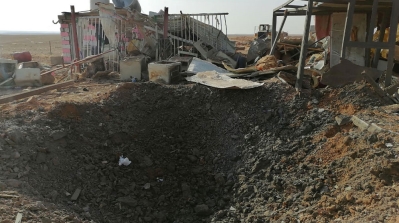
At least four Kataib Hezbollah commanders were among the dead, the sources said, adding that one of the raids had hit the Iran-backed group’s headquarters near the western al-Qaim district on the border with Syria.
Iran strongly condemned the attacks, with a government spokesman saying: “America has shown its firm support for terrorism and its neglect for the independence and sovereignty of countries and it must accept consequences for its illegal act.”
Protesters storm US embassy
On December 31, enraged members and supporters of pro-Iranian paramilitary groups in Iraq broke into the heavily fortified US embassy compound in Baghdad, smashing a main door and setting parts of its perimeter on fire.
Trump blamed Iran for killing the US contractor and the ensuing tensions around the embassy.
“Iran is orchestrating an attack on the US Embassy in Iraq. They will be held fully responsible,” he wrote on Twitter.
….Iran will be held fully responsible for lives lost, or damage incurred, at any of our facilities. They will pay a very BIG PRICE! This is not a Warning, it is a Threat. Happy New Year!
— Donald J. Trump (@realDonaldTrump) December 31, 2019
US troops and Iraqi security forces fired tear gas and stun grenades at the protesters, PMF members and their supporters who had encircled the embassy compound.
The sit-in ended on January 1, 2020.
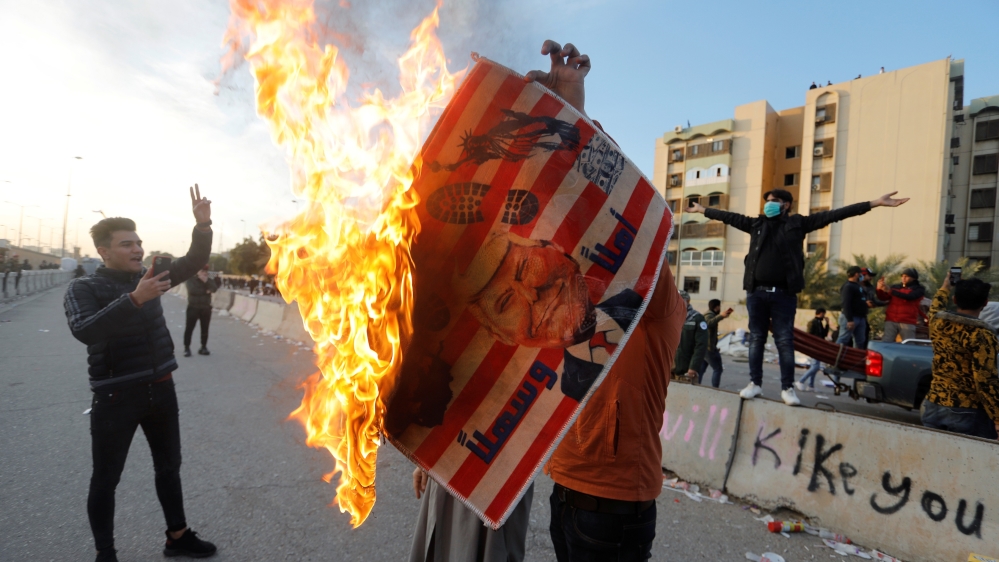
2020
Esper warns Iran may be planning attacks on US interests
Meanwhile, on January 2, US Secretary of Defense Mark Esper said there were “some indications” that Iran or groups it supports “may be planning additional attacks” on US interests in the Middle East.
“If that happens, then we will act. And by the way, if we get word of attacks or some type [of] indication, we will take pre-emptive action as well to protect American forces to protect American lives,” the Pentagon chief told reporters.
US assassinates Soleimani
In a predawn air raid in at Iraq’s airport in Baghdad on January 3, the US struck and killed Qassem Soleimani, the head of Iran’s elite Quds Force, and Abu Mahdi al-Muhandis, the deputy commander of Iran-backed militias known as the Popular Mobilisation Forces, or PMF.
Iran vowed harsh retaliation.
‘Tantamount’ to war
Iran’s UN ambassador Majid Takht Ravanchi in an interview with CNN on January 3 said that “the response for a military action is a military action.”
“So, that was … a new chapter which is tantamount to opening a war against Iran,” Ravanchi said.
Earlier on Friday, Ravanchi said in a letter that killing Soleimani “is an obvious example of State terrorism and, as a criminal act, constitutes a gross violation of the fundamental principles of international law, including, in particular…the Charter of the United Nations.”
Foreign Minister Mohammad Javad Zarif said the attack was an act of “international terrorism” and Iran would take legal action to hold Washington to account.
The US' act of international terrorism, targeting & assassinating General Soleimani—THE most effective force fighting Daesh (ISIS), Al Nusrah, Al Qaeda et al—is extremely dangerous & a foolish escalation.
The US bears responsibility for all consequences of its rogue adventurism.
— Javad Zarif (@JZarif) January 3, 2020
Trump: 52 sites could be targeted if Iran retaliates
In a Tweet on January 4 Trump threatened to hit 52 Iranian sites “very hard” if Iran attacked Americans or US assets.
The 52 targets represented the 52 Americans who were held hostage in Iran for 444 days after being seized at the US embassy in Tehran in November 1979, he added.
….targeted 52 Iranian sites (representing the 52 American hostages taken by Iran many years ago), some at a very high level & important to Iran & the Iranian culture, and those targets, and Iran itself, WILL BE HIT VERY FAST AND VERY HARD. The USA wants no more threats!
— Donald J. Trump (@realDonaldTrump) January 4, 2020
Trump also threatened to attack Iranian cultural sites, which could constitute a war crime if carried out. Following widespread outrage, Trump at first doubled down, but later walked back that threat, and said he would reluctantly follow international law.
Iraqi parliament calls for expulsion of foreign troops
Iraq’s parliament passed a resolution on January 5 calling on the government to expel foreign troops from the country and to cancel its request for assistance from the US-led coalition which had been working with Baghdad to fight the ISIL (ISIS).
Thousands mourn Soleimani during funeral
Tens of thousands of mourners clad in black filled the streets of Iran’s Mashhad and Ahvaz on January 5 to pay their respects to Soleimani.
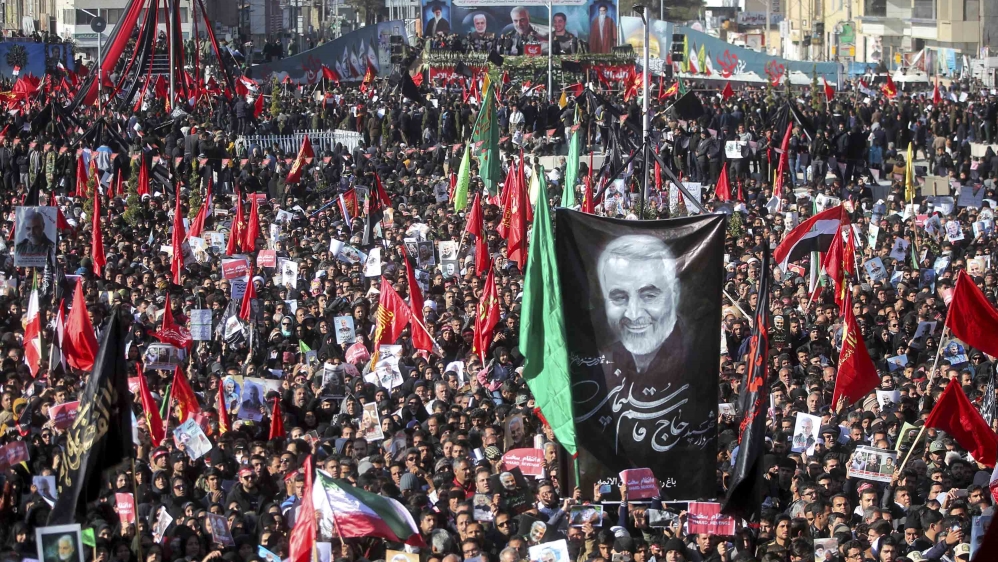
In live footage aired on Iranian state television, mourners were seen marching through Ahvaz holding up portraits of Soleimani, and crowds thronging Mollavi Square with flags in green, white and red – depicting the blood of “martyrs”.
Men and women wept as they beat their chests to the sound of chants.
Iran abandons nuclear deal limits
Iran on January 5 said it will no longer abide by the enrichment limits in its 2015 nuclear deal with world powers.
The deal, negotiated between Tehran and the five permanent members of the UN Security Council and Germany, prevent Iran from having enough nuclear material to build an atomic weapon.
In a televised address, Iran insisted it remained open to negotiations with European partners who have so far been unable to offer a way for Tehran to sell its crude oil abroad in light of US sanctions.
Trump steps up rhetoric against Iran
Trump continued his heated rhetoric against Iran and Iraq on January 6, warning of a “major retaliation” if Iran struck back in reprisal and threatened sanctions on Iraq after is parliament called on US troops to leave the country.
“If it happens, it happens. If they do anything, there will be major retaliation,” Trump said.
US defence chief: US military has no plans to leave Iraq
Defense Secretary Mark Esper told Pentagon reporters on January 6 that the US has no plans to pull out militarily from Iraq, following reports of a US letter about preparations for a withdrawal.
Esper added that the US was still committed to countering ISIL in Iraq, alongside US allies and partners.
The letter, which was widely circulated on social media and cited by news agencies, was sent to the Iraqi military by US Marine Corps Brigadier General William H Seely III, commanding general of Task Force Iraq, the US-led military coalition against ISIL.
But US Army General Mark Milley, chairman of the Joint Chiefs of Staff, told reporters that the letter was a poorly worded draft document that was only meant to underscore increased movement of forces.
White House adviser: Trump could still negotiate nuclear deal
White House adviser Kellyanne Conway on January 6 said Trump was confident he could still renegotiate a new nuclear deal with Tehran.
“He said he’s open. If Iran wants to start behaving like a normal country … sure, absolutely,” she said.
‘Never threaten the Iranian nation,’ Rouhani tells Trump
Iranian President Hassan Rouhani in a tweet on January 6 said nobody should threaten his nation, referring to the 1988 shooting down of an Iranian airliner by a US warship in which 290 were killed.
Those who refer to the number 52 should also remember the number 290. #IR655
Never threaten the Iranian nation.— Hassan Rouhani (@HassanRouhani) January 6, 2020
US denies Zarif a visa to attend UN
The US denied a visa to Zarif on January 6 that would have allowed him to attend an upcoming UN Security Council meeting in New York.
Under the 1947 UN “headquarters agreement”, the US is generally required to allow access to the United Nations for foreign diplomats. But Washington said it can deny visas for “security, terrorism and foreign policy” reasons.
Denying me a visa in violation of 1947 UNHQ Agreement pales in comparison to:
-Pompeo's threat to starve Iranians (crime against humanity)
-Trump's bluster about cultural heritage (war crime)
–#EconomicTerrorism
-Cowardly assassinationBut what are they really afraid of? Truth?
— Javad Zarif (@JZarif) January 7, 2020
Iran considering 13 ‘revenge scenarios’
The secretary of Iran’s Supreme National Security Council Ali Shamkhani said on January 7 that Iran was considering 13 “revenge scenarios” in retaliation.
“The Americans should know that until now 13 revenge scenarios have been discussed in the council and even if there is consensus on the weakest scenario carrying it out can be a historic nightmare for the Americans,” he said according to the semi-official Fars news agency.
Scores killed during stampede at Soleimani’s funeral
At least 56 people were killed in a stampede in the southeastern Iranian city of Kerman at the funeral procession for Soleimani.
Iran ‘ready to come back to full compliance’
Iran is “ready to come back to full compliance” with its nuclear deal with world powers, deputy foreign minister Abbas Araqchi said on January 7, according to a foreign ministry tweet, without providing any information on possible conditions.
Araghchi: Iran is ready to come back to full compliance of #JCPOA.#TDF2020 pic.twitter.com/ybBdNmwfl2
— Iran Foreign Ministry 🇮🇷 (@IRIMFA_EN) January 7, 2020
US ready to finish any war started with Iran – Esper
US Defense Secretary Mark Esper said on January 7 that the US wants to de-escalate the current tensions with Iran, but the country is ready to finish any war that could be started.
“We are not looking to start a war with Iran but we are prepared to finish one,” he told CNN. “What we’d like to see is the situation de-escalated.”
Iran launches attacks on US forces
In the early hours of January 8, Iran launched a series of missile attacks on two Iraqi bases housing US troops.
Iranian state television said the Islamic Revolutionary Guard Corps (IRGC) had attacked the Ain al-Assad military base, where US troops are stationed. A second facility near Erbil airport was also hit.
The Iraqi military said in a statement that 22 missiles were launched on the two sites between 1:45am and 2:15am local time (22:45 and 23:15 GMT, January 7). Two of the 17 missiles targeting Ain al-Assad base did not go off, the military said, while the five missiles on Erbil all targeted coalition headquarters.
In a Tweet, Zarif said Iran had taken and concluded “proportionate measures in self-defence” under Article 51 of the UN Charter.
Iran took & concluded proportionate measures in self-defense under Article 51 of UN Charter targeting base from which cowardly armed attack against our citizens & senior officials were launched.
We do not seek escalation or war, but will defend ourselves against any aggression.
— Javad Zarif (@JZarif) January 8, 2020
In Washington, Trump said in a tweet that an assessment of casualties and damage from the strikes was underway.
All is well! Missiles launched from Iran at two military bases located in Iraq. Assessment of casualties & damages taking place now. So far, so good! We have the most powerful and well equipped military anywhere in the world, by far! I will be making a statement tomorrow morning.
— Donald J. Trump (@realDonaldTrump) January 8, 2020
‘Slap in the face’ for US
Iran’s Khamenei on January 8 said Tehran’s missile attacks on US targets in Iraq was a “slap in the face” for the US and said Washington’s troops must leave the region.
“Last night, we slapped them in the face,” Khamenei said in his speech in the capital, Tehran, adding that military retaliation was not enough.
“What is important is that the corrupt presence of the US in this region should come to an end.”
New ‘powerful’ sanctions on Iran
Later on January 8, Trump said Iranian missile strikes on bases in Iraq did not harm any US troops stationed there and damage was minimal, an outcome he said showed Tehran wanted to de-escalate a standoff.
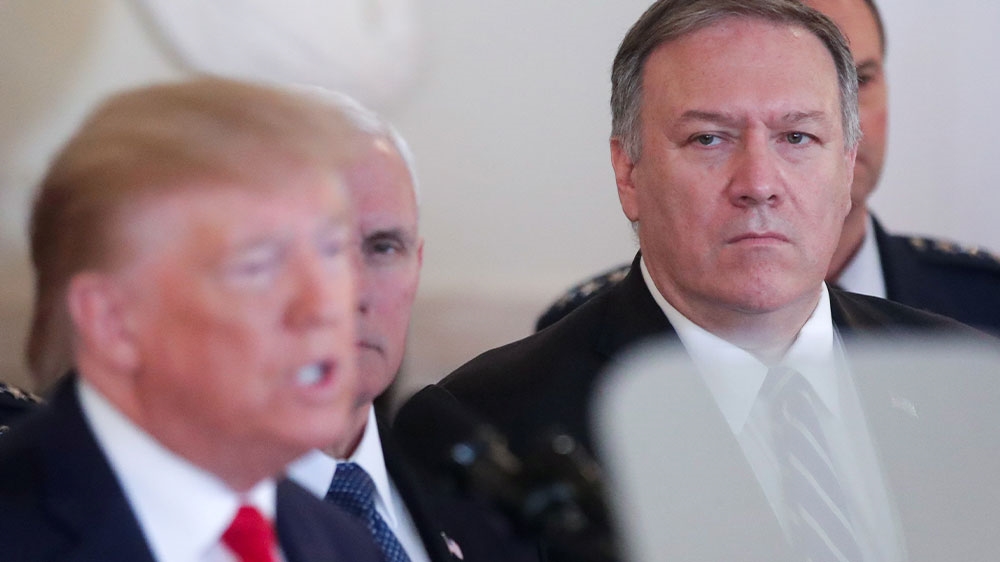
Iran “appears to be standing down”, Trump said from the White House.
Trump announced the US would immediately impose new “powerful” sanctions until “Iran changes its behaviour”.